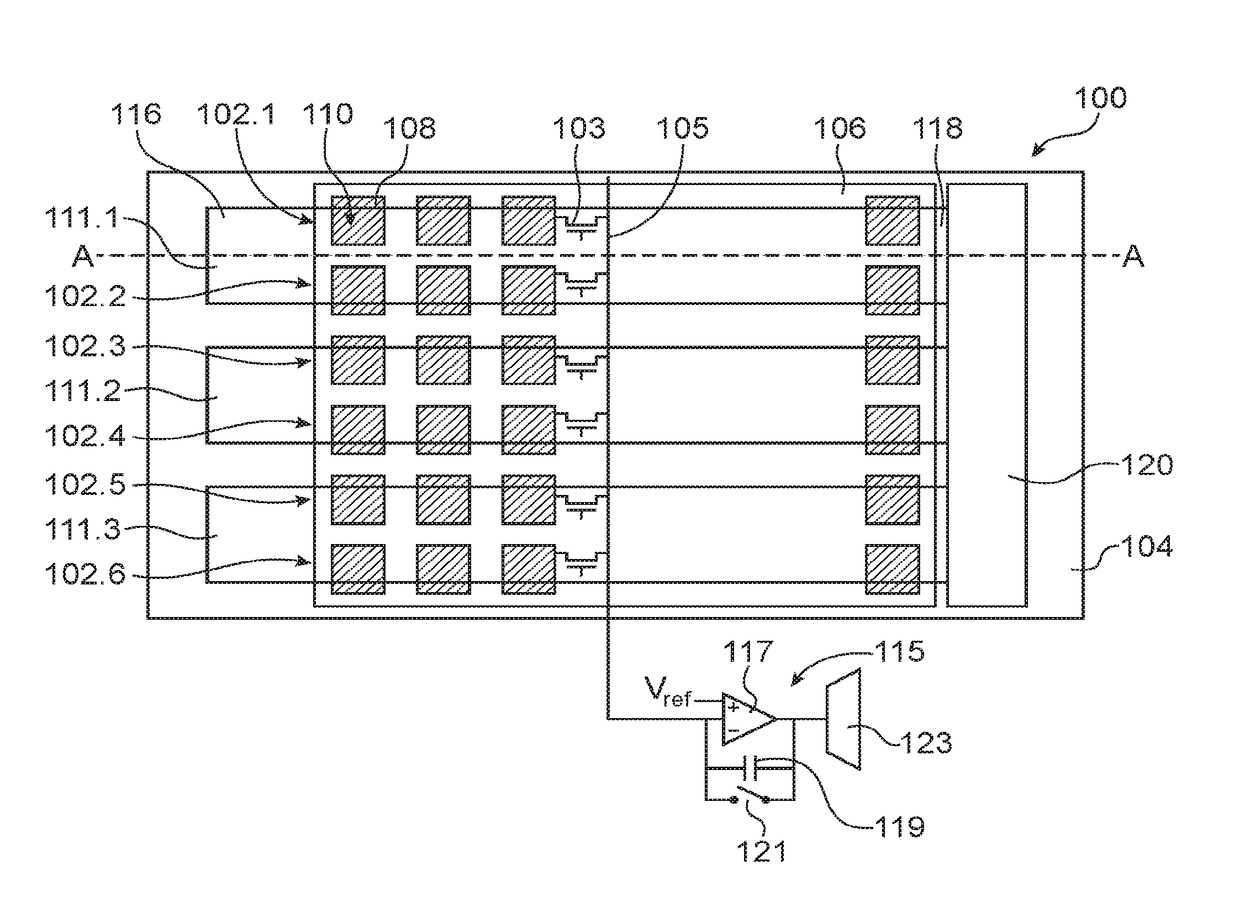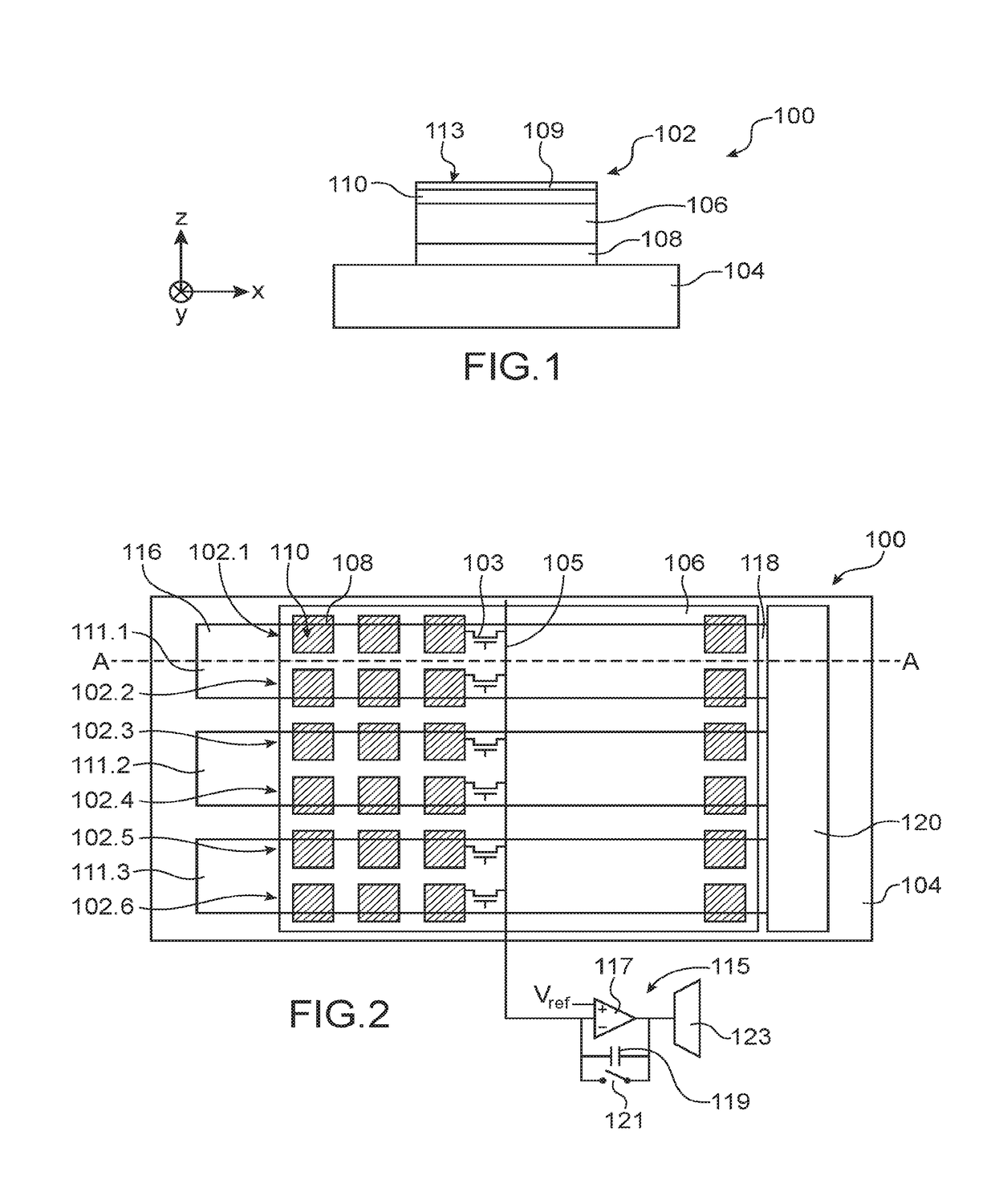Thermal pattern sensor with shared heating elements
a technology of thermal pattern sensor and heating element, applied in the field of thermal pattern sensor, can solve the problems of sensor drawback, level of signal obtained, resolution that can be achieved with these techniques, and incompatible with the resolutions sought for certain thermal pattern sensor
- Summary
- Abstract
- Description
- Claims
- Application Information
AI Technical Summary
Benefits of technology
Problems solved by technology
Method used
Image
Examples
first embodiment
[0017] the thermal pattern sensor may be such that:[0018]each pixel moreover comprises a selection transistor connected to the reading electrode of said pixel,[0019]for each line of pixels, the gates of the selection transistors for said line of pixels are connected to a selection line of said line of pixels,[0020]for each column of pixels, the selection transistors of the pixels of said column of pixels are connected to a reading column of said column of pixels which is connected to a reading circuit common to the pixels of said column of pixels.
[0021]In this case the thermal pattern sensor may moreover comprise a control circuit capable of implementing at least the following steps for reading a line of pixels:[0022]setting the selection transistors of the pixels of said line to an ON state;[0023]application of a heating voltage to the ends of the electrically conductive portion associated with said line of pixels;[0024]re-initialisation of the reading circuits;[0025]waiting during...
second embodiment
[0032] it is possible for the thermal pattern sensor to be such that:[0033]each pixel moreover comprises at least one selection transistor connected to the reading electrode of said pixel,[0034]the gates of the selection transistors of the pixels belonging to adjacent lines of pixels capable of being heated simultaneously by a given electrically conductive portion are connected to a single common selection line for said lines of pixels,[0035]for each column of pixels, the selection transistors whose gates are connected to the same selection line are connected to different reading columns, each connected to a different reading circuit.
[0036]Compared to the first embodiment, the sensor according to this second embodiment comprises a greater number of reading columns, as well as a greater number of reading circuits. Due to the fact that the lines of pixels heated by a given electrically conductive portion may be read simultaneously, the reading of the pixels is simplified, and there is...
third embodiment
[0142]FIG. 5 shows the sensor 100 according to a
[0143]In comparison with the previous embodiments, and for at least some of the lines of pixels 102 of the sensor 100, each of the reading electrodes 108 of these lines of pixels 102 is not distinct for each of the pixels 102, but is common to two pixels from a given column and which are heated by different portions 111. Thus for two adjacent lines of pixels each of which is associated with a different portion 111, the reading electrodes of two pixels found in a given column are electrically connected together due to the fact that they are formed by the same portion of the electrically conductive material. In the example shown in FIG. 5, the reading electrodes of the pixels of a given column, and which belong to two lines of pixels 102.2 and 102.3, each associated with a different heating element (the heating elements of the line of pixels 102.2 being formed by the portion 111.1 and those of the line of pixels 102.3 being formed by the...
PUM
 Login to View More
Login to View More Abstract
Description
Claims
Application Information
 Login to View More
Login to View More - R&D
- Intellectual Property
- Life Sciences
- Materials
- Tech Scout
- Unparalleled Data Quality
- Higher Quality Content
- 60% Fewer Hallucinations
Browse by: Latest US Patents, China's latest patents, Technical Efficacy Thesaurus, Application Domain, Technology Topic, Popular Technical Reports.
© 2025 PatSnap. All rights reserved.Legal|Privacy policy|Modern Slavery Act Transparency Statement|Sitemap|About US| Contact US: help@patsnap.com



